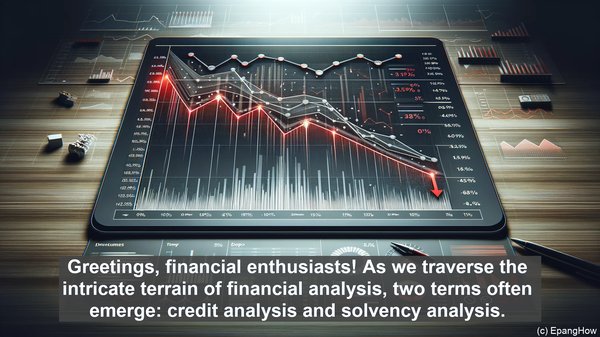Introduction: Unraveling the World of Financial Analysis
Greetings, financial enthusiasts! As we traverse the intricate terrain of financial analysis, two terms often emerge: credit analysis and solvency analysis. While they may seem similar, they possess distinct characteristics and serve different purposes. Today, we embark on a journey to demystify these concepts, equipping you with the knowledge to navigate the financial landscape with confidence.
Section 1: Credit Analysis – Assessing Creditworthiness
Credit analysis primarily revolves around evaluating an entity’s creditworthiness. In simpler terms, it aims to determine the likelihood of a borrower repaying their debt obligations. This analysis encompasses a comprehensive assessment of various factors, including the borrower’s financial history, income stability, and existing debt. By scrutinizing these elements, credit analysts gauge the borrower’s ability and willingness to fulfill their financial commitments.
Section 2: Solvency Analysis – Peering into Long-Term Viability
While credit analysis focuses on short-term debt repayment, solvency analysis takes a broader perspective. It delves into an entity’s long-term financial health, aiming to ascertain its ability to meet all financial obligations, not just debt repayments. Solvency analysis often involves an in-depth examination of an entity’s balance sheet, evaluating its assets, liabilities, and equity. This assessment aids in understanding the entity’s overall financial stability and its capacity to endure in the long run.

Section 3: The Time Factor: Short-Term vs Long-Term
One of the key distinctions between credit analysis and solvency analysis lies in the time horizon. Credit analysis predominantly focuses on short-term considerations, such as the borrower’s immediate ability to repay a loan. In contrast, solvency analysis encompasses a more extended timeframe, encompassing an entity’s financial viability over the long haul. This temporal disparity underscores the varying objectives and scope of these analyses.
Section 4: The Risk Dimension: Immediate vs Future
Another crucial aspect to consider is the risk dimension. Credit analysis primarily concerns itself with the immediate risk associated with a borrower defaulting on their debt. It aims to quantify this risk and determine the appropriate terms for lending. On the other hand, solvency analysis delves into the broader risk landscape, assessing an entity’s overall financial stability and its susceptibility to future financial challenges. By doing so, it aids in identifying potential red flags and mitigating long-term risks.
Section 5: The Complementary Nature: A Holistic View
While credit analysis and solvency analysis have their unique objectives, they are not mutually exclusive. In fact, they complement each other, offering a comprehensive view of an entity’s financial standing. By conducting both analyses, financial professionals can gain a nuanced understanding of an entity’s creditworthiness, immediate risk profile, and long-term viability. This holistic perspective is invaluable in making informed financial decisions and managing risk effectively.

